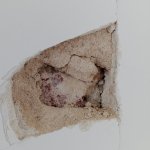nedc
New Member
Hi all,
Three months ago, I had walls re-plastered and painted by a plaster/paint company. The walls which were taken down to the brick and built back up are fine - no problems. But the walls which were "spot" plastered (plastered where needed) are now showing large spider cracks (2mm). The plaster used throughout is a mineral plaster render from Keim.
The contractor claims: 1) his workers did their job and removed the old plaster and that any old plaster that was not removed falls into the "unforeseen" issue category and is the owner's responsibility. 2) the Keim plaster render reacted with the old plaster and caused it to weaken and fall away from the brick wall (the contractor is blaming the Keim product)
Another contractor looked at the walls. This contractor believes that not enough of the old plaster was removed from the walls before the new plaster was applied, and that the new plaster was not able to fix itself to a sound surface area.
The photo shows a cracked area that the 2nd contractor dug out. The old plaster is dry and crumbles very easily.
The contractor claims there is "no way to know if plaster is old" before new plaster is applied.
My question: What methods are use by professional plasterers to assess the condition of plaster on a wall and determine if it needs a full renovation or just spot plastering?
Three months ago, I had walls re-plastered and painted by a plaster/paint company. The walls which were taken down to the brick and built back up are fine - no problems. But the walls which were "spot" plastered (plastered where needed) are now showing large spider cracks (2mm). The plaster used throughout is a mineral plaster render from Keim.
The contractor claims: 1) his workers did their job and removed the old plaster and that any old plaster that was not removed falls into the "unforeseen" issue category and is the owner's responsibility. 2) the Keim plaster render reacted with the old plaster and caused it to weaken and fall away from the brick wall (the contractor is blaming the Keim product)
Another contractor looked at the walls. This contractor believes that not enough of the old plaster was removed from the walls before the new plaster was applied, and that the new plaster was not able to fix itself to a sound surface area.
The photo shows a cracked area that the 2nd contractor dug out. The old plaster is dry and crumbles very easily.
The contractor claims there is "no way to know if plaster is old" before new plaster is applied.
My question: What methods are use by professional plasterers to assess the condition of plaster on a wall and determine if it needs a full renovation or just spot plastering?



